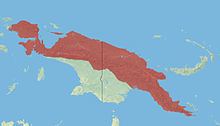Infraclass Marsupialia Scientific name Dasyurus albopunctatus Rank Species | Phylum Chordata Genus Dasyurus Higher classification Quoll | |
 | ||
Similar Bronze quoll, Three‑striped dasyure, Speckled dasyure, Myoictis, Murexia | ||
The New Guinean quoll (Dasyurus albopunctatus), also known as the New Guinea quoll or New Guinea native cat, is a carnivorous marsupial mammal native to New Guinea. It is the second-largest surviving marsupial carnivore of New Guinea.
Contents
Taxonomy
The New Guinean quoll belongs to Dasyuridae, a family of carnivorous marsupials, which includes other species of quolls, the extinct thylacine, the Tasmanian devil, and many smaller carnivores. It is one of six extant species of quolls, four of which are found in only in Australia and two of which are restricted to New Guinea (the bronze quoll is the other New Guinean species). Both the quolls found in New Guinea seem to be most closely related to the Australian western quoll.
Description
The New Guinean quoll is small, usually weighing just over 1 lb (0.45 kg). Its body is brown and the back spotted with white; the spots do not extend onto the lightly haired tail. It resembles a cat-like opossum; the quolls are also referred to as "native cats" and occasionally "marsupial cats" or "tiger cats". Its feet have transversely striated pads, which is likely to be an adaptation for grip and is indicative of a life spent in the trees. It lives throughout the forests of New Guinea at elevations up to 11,000 ft (3300 m) but usually closer to 3,000 ft (900 m). The population appears to be centered in the highlands of New Guinea.
Behaviour and diet
Quolls feed on a large range of prey, including birds, rats, other marsupials, small reptiles, and insects. They are reported to feed on prey larger than themselves. They are good climbers, but also spend time on the forest floor. Although nocturnal, they spend the daylight hours basking in the sun. They nest in rocky banks, hollow logs, or small caves. In captivity, the longest recorded survival is three years, but their lifespan in the wild is unknown.
Threats
The number of New Guinean quolls is believed to be decreasing as a result of human encroachment into their habitat and the associated loss of cover. Because they are known to scavenge, persecution by humans may be putting pressure on the population. They also face predation and competition from introduced species such as dogs, cats and foxes.
